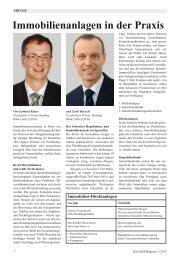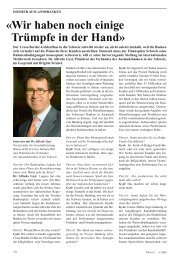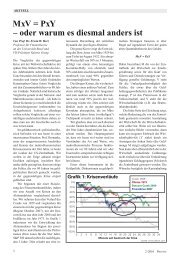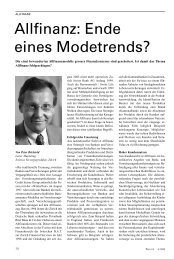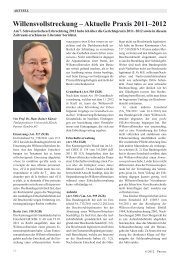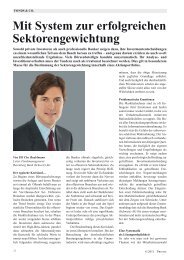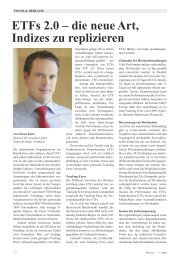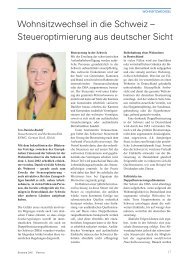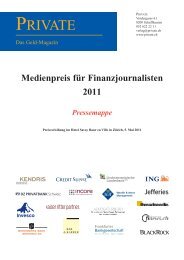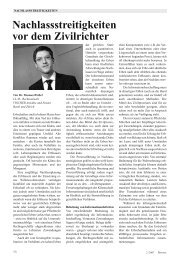more... - Private Magazin
more... - Private Magazin
more... - Private Magazin
- TAGS
- private
- magazin
- private.ag
Erfolgreiche ePaper selbst erstellen
Machen Sie aus Ihren PDF Publikationen ein blätterbares Flipbook mit unserer einzigartigen Google optimierten e-Paper Software.
U.S. EQUITY MARKET<br />
The U.S. Equity Market After the Crisis –<br />
Retrospect and Prospect<br />
U.S. equities have recovered impressively since their March 2009 low, with the S&P 500 index up <strong>more</strong> than 100%<br />
and annual earnings for S&P 500 companies <strong>more</strong> than doubling. Severe recession and acute financial crisis have<br />
given way to a period of slow growth, with unemployment elevated and the government-debt-to-GDP ratio at a<br />
peacetime record. Federal Reserve policy remains highly stimulative, with experiments such as asset purchases<br />
that are without precedent in U.S. financial history. A relatively fragile U.S. economic recovery is also threatened<br />
by risks outside the country, most notably the prospect of financial accidents stemming from Europe’s debt crisis.<br />
Do these risks and uncertainties mean that the recovery in U.S. stocks must come to an end? What kinds of returns<br />
should investors expect from U.S. equities over the next five to ten years?<br />
By Eugene Lancaric<br />
Consultant, Economics and Asset Allocation, ING Investment Management<br />
In collaboration with Zane Howard<br />
Asset Allocation Analyst, ING Investment Management<br />
Looking forward<br />
Any attempt to gauge prospects for<br />
U.S. stocks over the next several years<br />
must start with the recognition that the<br />
U.S. economy is still far from steadystate<br />
equilibrium. We expect, however,<br />
that economic activity, driven prima -<br />
rily by a continued revival in domestic<br />
demand, will grow rapidly enough over<br />
the next several years to permit the unemployment<br />
rate gradually to fall back<br />
to the “natural rate” determined by<br />
structural labor-market conditions. (We<br />
estimate this rate at between 6.0% and<br />
6.5%, somewhat above the Federal Reserve’s<br />
estimate.)<br />
As unemployment falls to cycli -<br />
cally normal levels, monetary policy<br />
can and should eventually be normalized<br />
as well, neutralizing and ultimately<br />
reversing its now highly stimulative<br />
posture. We believe that the Federal<br />
Reserve has appropriate tools to bring<br />
about this reversal, even though many<br />
of the steps it has taken in this episode<br />
have gone beyond traditional measures.<br />
This move back to equilibrium<br />
should also involve a shift in sources of<br />
growth between developed and emerging<br />
markets. The U.S., Western Europe<br />
and other developed economies are<br />
likely to rely <strong>more</strong> on business invest-<br />
ment and exports than on consumption<br />
and housing as sources of growth.<br />
Emerging economies should become<br />
less reliant on investment in export-oriented<br />
production capacity and derive<br />
growth instead from domestic demand,<br />
particularly for services, as living standards<br />
rise.<br />
On balance, we expect that by<br />
2015–16, the U.S. economy should be<br />
growing at a steady-state real growth<br />
rate of about 2.5%, inflation should be<br />
in line with the Federal Reserve’s 2.0%<br />
target, and that the Fed will have begun<br />
to raise the Fed Funds target rate back<br />
to about 4.5%. We also expect the U.S.<br />
trade deficit to shrink from about 3.0%<br />
to about 2.0% of GDP through the<br />
global rebalancing that accompanies<br />
this gradual convergence.<br />
Earnings growth<br />
This process sets the context for U.S.<br />
financial asset returns over the next<br />
several years. The primary drivers of<br />
returns should be economic growth<br />
and policy normalization, in which<br />
moderate GDP growth and low inflation<br />
lead to continued earnings growth<br />
while short- and long-term interest<br />
rates rise. In our view, this environment<br />
should be encouraging for equities, but<br />
we recognize that many investors are<br />
concerned over the prospects for further<br />
earnings growth and whether stock<br />
prices can rise in the face of higher<br />
interest rates.<br />
Historically high levels of the<br />
profits-to-GDP ratio and of S&P 500<br />
margins have led many investors to fear<br />
that earnings will grow <strong>more</strong> slowly<br />
than revenues in coming years as margins<br />
decline back to long-run averages.<br />
We dissent from this view. We believe<br />
18 6/2012 PRIVATE




